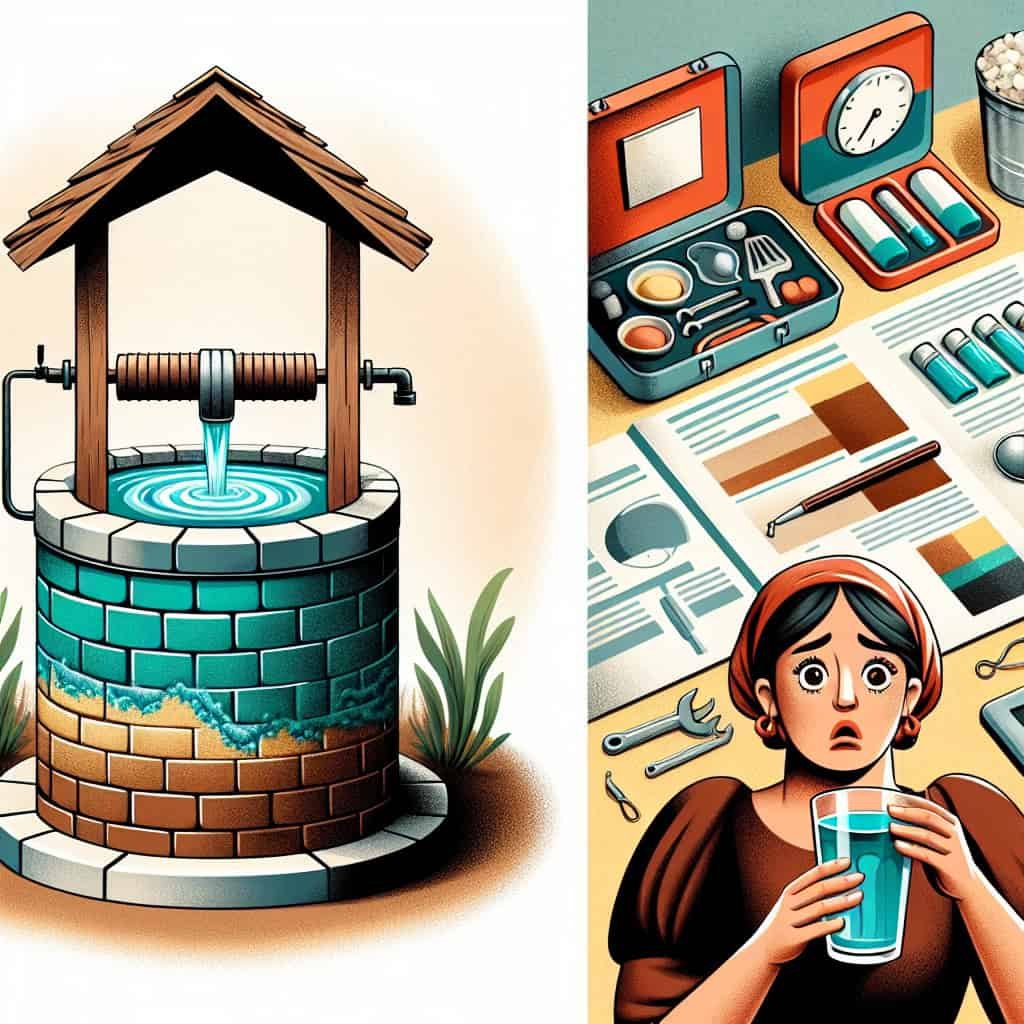In regions with high iron and manganese levels, ensuring the safety of your well water becomes a top priority. These elements can pose potential health risks and affect the taste and smell of your drinking water. Luckily, there are several steps you can take to ensure the safety of your well water, from regular testing and monitoring to installing appropriate filtration systems. By being proactive and knowledgeable about well water safety, you can protect yourself and your loved ones from any potential harm.

Understanding the Dangers of High Iron and Manganese Levels
Iron and manganese are two common minerals found in well water. While these minerals may not pose a direct health threat, high levels of iron and manganese can lead to various problems in terms of water quality and overall well system functionality. It is crucial to understand the effects and potential health risks associated with these high levels to ensure the safety of your well water.
Effects of High Iron Content in Well Water
Having high iron content in your well water can result in numerous noticeable effects. One common effect is the discoloration of water, where it may appear yellow, red, or brown. This discoloration can be frustrating as it affects the aesthetics of your water, making it unappealing for daily use, such as drinking, cooking, and laundry.
Furthermore, high iron levels can lead to the accumulation of iron sludge or sediment in plumbing fixtures, pipes, and appliances. This build-up can restrict water flow, causing clogs and reduced water pressure over time. Additionally, the presence of iron bacteria in well water can lead to the formation of slimy biofilm in plumbing systems, which can contribute to foul odors and tastes.
Effects of High Manganese Content in Well Water
Similar to high iron content, high manganese content in well water can have adverse effects on both water quality and well system functionality. One significant effect is the discoloration of water, which can range from light yellow to dark brown. This discoloration can stain plumbing fixtures, laundry, and dishes, making them appear unsightly.
Furthermore, the presence of high manganese levels in well water can lead to the formation of manganese deposits or scale. This scale can accumulate inside plumbing fixtures, pipes, and appliances, restricting water flow and decreasing water pressure over time. Moreover, manganese can contribute to the growth of manganese bacteria, resulting in slimy films and foul tastes.
Potential Health Risks Associated with High Iron and Manganese Levels
While high iron and manganese levels may not directly cause severe health issues, prolonged exposure to these minerals can have potential health risks. For individuals with certain health conditions, such as iron overload disorders or liver disease, excessive iron consumption can worsen their condition.
Similarly, prolonged ingestion of high manganese levels can lead to manganese toxicity, resulting in neurological symptoms such as tremors, muscle stiffness, and cognitive impairment. Infants, children, and individuals with compromised liver function may be more susceptible to these effects.
It is essential to take these potential health risks seriously and ensure that the iron and manganese levels in your well water are within safe limits. Regular testing, proper treatment, and maintenance of your well system are crucial to protecting your health and the well-being of your household.
Testing and Monitoring Well Water Quality
Importance of Regular Water Testing
Regular testing of well water is vital to ensure its safety and to promptly address any water quality issues. Well water quality can vary over time, and it is crucial to monitor changes in iron and manganese levels. By conducting routine water testing, you can identify any increases or decreases in these minerals’ concentrations and take appropriate measures to address them.
Furthermore, water testing enables you to evaluate the overall quality of your well water and detect any other potential contaminants that might be present. This comprehensive information allows you to make informed decisions regarding appropriate treatment methods and necessary maintenance.
Choosing the Right Testing Method
When it comes to testing well water, it is essential to choose the right method that accurately reflects the potential presence of iron and manganese. Traditional laboratory testing is a reliable option, providing accurate results based on analytical methods and equipment. However, it may require additional time and costs to obtain these results.
Alternatively, you can opt for rapid testing kits or in-home test strips, which provide immediate results. While these testing methods offer convenience, they may not be as accurate or comprehensive as laboratory testing. If you choose rapid testing kits or test strips, it is advisable to confirm the results with a certified laboratory if you have any concerns.
Identifying Iron and Manganese Concentrations in Well Water
Once you have obtained the results of your well water test, it is crucial to identify the concentrations of iron and manganese present. These concentrations will help determine the severity of the problem and guide you in selecting the appropriate treatment techniques.
Iron concentrations are typically measured in milligrams per liter (mg/L) or parts per million (ppm), while manganese concentrations are measured in the same units. By understanding the levels of iron and manganese in your well water, you can assess whether they are within acceptable limits or require treatment.
Determining the Source of Contamination
Identifying the source of iron and manganese contamination in your well water is essential for effectively addressing the problem. The source could be natural, such as from the surrounding soil and rocks, or it could be due to man-made factors like industrial activities or nearby waste disposal sites.
Determining the source of contamination will guide you in taking appropriate preventive measures and selecting the most suitable treatment techniques. Consulting with water quality professionals or environmental experts can provide valuable insights into the potential sources and ways to mitigate them.
Water Treatment Techniques for High Iron and Manganese
Water Softening
Water softening is a commonly used treatment technique for reducing the levels of iron and manganese in well water. It involves the use of a water softener unit that exchanges calcium and magnesium ions, which are typically present in hard water, with sodium or potassium ions.
While water softeners can effectively remove low to moderate concentrations of iron and manganese, they are not suitable for severe cases. Additionally, the sodium or potassium added during the softening process may not be ideal for individuals on low-sodium diets.
Oxidation and Filtration Systems
Oxidation and filtration systems are effective methods for removing iron and manganese from well water. This treatment technique involves the oxidation of these minerals, converting them into solid particles that can be easily filtered out.
Different types of filtration media, such as manganese greensand, Birm, or activated carbon, can be utilized to capture and remove the oxidized iron and manganese particles. These systems are highly efficient in removing even high levels of iron and manganese, providing clean and clear water.
Ion Exchange
Ion exchange is another treatment method that effectively removes iron and manganese from well water. This technique involves the exchange of iron and manganese ions with desirable ions, such as sodium or potassium ions, on a resin bed.
Similar to water softening, ion exchange systems can effectively remove moderate levels of iron and manganese. However, they may require periodic regeneration or replacement of the resin bed to maintain their efficiency.
Chemical Oxidation
Chemical oxidation is a treatment technique used for removing high concentrations of iron and manganese from well water. It involves the addition of oxidizing agents, such as chlorine or potassium permanganate, which react with the iron and manganese to form solid particles.
Once the particles have settled, they can be removed through filtration or sedimentation processes. Chemical oxidation is often used as a pre-treatment step in conjunction with other filtration techniques for optimal results.
Sequestration
Sequestration is an alternative method used to control the effects of high iron and manganese levels rather than removing them entirely. It involves the addition of sequestering agents, such as polyphosphates, that bind with iron and manganese ions to prevent their precipitation and subsequent staining.
While sequestration may not eliminate the presence of iron and manganese, it can mitigate their effects on water quality and prevent the development of scale or biofilm. However, it is important to note that sequestration does not address the potential health risks associated with consuming iron and manganese.
Maintenance and Upkeep of Well Water Treatment Systems
Regular Inspections and Cleanings
To ensure the efficient operation of well water treatment systems, regular inspections and cleanings are essential. This involves checking the system components, such as tanks, filters, and valves, for any signs of damage or blockages. Regular cleaning of filters or backwashing is also necessary to maintain optimal performance.
Performing these regular inspections and cleanings allows you to identify any issues or malfunctions promptly. By addressing them early on, you can prevent potential system failures or reduced treatment efficiency, ensuring the consistent quality of your well water.
Replacing Filters and Media
Over time, the filters or media used in well water treatment systems can become clogged or lose their effectiveness. Regular replacement of these components is crucial to maintain optimal treatment efficiency.
The frequency of filter or media replacement will depend on usage, water quality, and the specific system being used. Refer to the manufacturer’s guidelines or consult with water treatment professionals to determine the appropriate replacement schedule for your specific system.
pH Adjustment
pH adjustment is an important aspect of maintaining well water treatment systems. Both iron and manganese removal processes are affected by pH levels, and maintaining the correct pH range is necessary for optimal treatment efficiency.
If the pH of your well water is outside the recommended range, adjustments can be made using pH adjustment chemicals or adding alkaline substances. Monitoring and maintaining appropriate pH levels will ensure that iron and manganese removal processes function effectively.
Professional Support and Assistance
Seeking professional support and assistance is highly beneficial when it comes to the maintenance and upkeep of well water treatment systems. Water treatment professionals have the expertise and knowledge to assess the performance of your system, provide necessary repairs or replacements, and offer guidance on proper maintenance practices.
By partnering with professionals who specialize in water treatment, you can ensure that your well water treatment system operates at its best, providing you with clean and safe water for years to come.

Well Water Testing and Treatment Costs
Cost of Initial Water Testing
The cost of initial water testing can vary depending on the testing method chosen and the specific parameters being analyzed. Laboratory testing typically provides more comprehensive results but may require additional time and costs. Rapid testing kits or in-home test strips offer convenience but may not be as accurate.
On average, the cost of laboratory testing for iron and manganese concentrations can range from $50 to $100. Rapid testing kits or in-home test strips usually cost between $10 and $50. It is crucial to consider the investment in accurate testing as a crucial step towards ensuring the safety of your well water.
Investing in Water Treatment Systems
Investing in water treatment systems for high iron and manganese levels can have a varied cost. The cost depends on the specific treatment system chosen, the severity of the problem, and the size of the system required to accommodate your well water flow rate.
Simple treatment systems, such as point-of-use filters, can range from $100 to $500. More complex systems, such as oxidation and filtration systems or ion exchange units, can range from $500 to $5000. It is important to evaluate the long-term benefits and costs of your chosen treatment system to make an informed investment decision.
Long-Term Maintenance Expenses
Apart from the initial investment in water treatment systems, there are long-term maintenance expenses to consider. These expenses include the replacement of filters, media, and chemicals used for treatment, as well as periodic inspections and cleanings.
The long-term maintenance costs will vary depending on the type of treatment system and the specific requirements of your well water. It is advisable to consult with water treatment professionals or refer to the manufacturer’s guidelines to estimate the ongoing expenses associated with your chosen treatment system.
Budgeting for Continuous Monitoring
Continuous monitoring of well water quality is crucial to ensure the effectiveness of treatment systems and the safety of your well water. This includes regular testing, monitoring changes in iron and manganese levels, and making adjustments or seeking professional assistance when necessary.
Budgeting for continuous monitoring requires considering the cost of routine water testing and potential maintenance or treatment adjustments as needed. Allocating a portion of your annual household budget towards water quality monitoring will ensure the ongoing protection and well-being of your household.
Preventing Iron and Manganese Contamination
Understanding the Causes of Contamination
Preventing iron and manganese contamination begins with understanding the potential sources. These minerals can enter well water through natural processes, such as the dissolution of iron and manganese-rich rocks and soils. Additionally, man-made factors like industrial activities or waste disposal sites can contribute to contamination.
Being aware of the potential sources of contamination in your area allows you to take preventive measures and minimize the risk of iron and manganese entering your well water. Regular inspections of nearby industrial sites or waste disposal facilities and understanding the geology of your location are essential preventive steps.
Protecting Well Infrastructure from Corrosion
Corrosion of well infrastructure can contribute to iron and manganese contamination. Corroded pipes or well casings can introduce these minerals into well water, compromising its quality.
To protect well infrastructure from corrosion, ensure that the materials used are corrosion-resistant, such as stainless steel or PVC piping. Regular inspections and maintenance of well components can identify any signs of corrosion early on, allowing for prompt repairs or replacements as needed.
Preventing Surface Water Runoff and Erosion
Surface water runoff and erosion can introduce iron and manganese into well water. When heavy rainfall occurs, surface water can carry these minerals from the surrounding landscape into wells, resulting in contamination.
Preventing surface water runoff and erosion can be achieved through various measures. Creating vegetative buffers, redirecting runoff, and implementing erosion control practices can help reduce the risk of iron and manganese contamination in your well water.
Addressing Nearby Waste Disposal Sites
Proximity to waste disposal sites, such as landfills or septic systems, can increase the risk of iron and manganese contamination in well water. These sites can release pollutants that might contain high concentrations of these minerals into the surrounding groundwater.
Regular monitoring of nearby waste disposal sites, understanding their practices and regulations, and participating in community initiatives or advocacy can help address potential contamination sources. By actively engaging in discussions and reporting any concerns, you can contribute to improved water quality in your area.

Safe Well Water Consumption Practices
Alternative Water Sources for Drinking and Cooking
If your well water has high iron and manganese levels, it is advisable to consider alternative sources for drinking and cooking purposes. Installing a separate point-of-use filtration system or utilizing bottled water can ensure that you have a reliable source of clean water for essential consumption.
However, it is important to note that utilizing alternative water sources for drinking and cooking addresses immediate concerns but does not eliminate the need for treating and maintaining the quality of your well water. Proper well water treatment and maintenance should still be practiced to ensure the overall safety of your water supply.
Limiting Exposure to Contaminated Water
Limiting your exposure to contaminated well water is crucial to minimize health risks. Avoiding activities such as swimming or bathing where water could be ingested or inhaled is advisable when the water has high iron and manganese levels.
Additionally, wearing protective clothing, such as gloves, when handling water that has visible discoloration or odors can prevent direct contact. These measures help reduce the potential risks associated with exposure to high iron and manganese levels.
Properly Maintaining Plumbing Fixtures
Proper maintenance of plumbing fixtures is essential to prevent the accumulation of iron and manganese sediment or scale. Regular cleaning and descaling of faucets, showerheads, and other fixtures can help remove any deposits and maintain optimal water flow.
Using plumbing fixtures specifically designed to handle well water with high mineral content can also help mitigate any potential corrosion or build-up. Consult with plumbing professionals or refer to manufacturer recommendations to ensure the appropriate fixtures are used for your water conditions.
Educating Household Members and Visitors
Educating household members and visitors about the presence of high iron and manganese levels in well water is crucial for their safety. Making everyone aware of the effects, potential health risks, and preventive measures will help ensure that proper precautions are taken.
Provide clear instructions on using alternative water sources for consumption, limiting exposure, and maintaining good hygiene practices. By creating awareness and promoting safe practices, you can protect the health and well-being of everyone in your household.
Water Health and Quality Education
Seeking Information from Local Health Agencies
Local health agencies or departments often provide valuable information and resources regarding water health and quality. They can offer guidance on water testing, treatment techniques, and potential health risks associated with high iron and manganese levels.
Contacting your local health agency or visiting their website can provide you with the most up-to-date and relevant information specific to your geographic area. Taking advantage of these resources will help you make informed decisions regarding the safety of your well water.
Joining Community Programs and Workshops
Many communities organize programs and workshops focused on water health and quality. Participating in such initiatives can provide you with access to experts, professionals, and fellow community members who share similar concerns and experiences.
Through these programs and workshops, you can learn about new technologies, treatment methods, and best practices for maintaining water quality. Additionally, you can build a network of support within your community, fostering collaboration and shared knowledge.
Utilizing Online Resources and Tools
The internet provides a wealth of information and resources for well water health and quality education. Numerous trusted websites, such as those managed by health agencies or environmental organizations, offer comprehensive guides, articles, and tools for assessing and addressing water-related concerns.
When utilizing online resources, it is essential to verify the credibility of the sources. Stick to trusted websites and institutions to ensure the accuracy and reliability of the information you find.
Attending Water Treatment Trainings
Water treatment trainings or workshops conducted by professionals in the field offer in-depth knowledge and practical skills to address well water health and quality concerns. These trainings often cover various topics, including testing methods, treatment techniques, and proper maintenance practices.
By attending water treatment trainings, you can gain a deeper understanding of well water management and become more self-sufficient in maintaining your well system’s health and optimizing water quality. Additionally, you can connect with industry experts and other participants, building a network of support and shared experiences.

Government Regulations and Guidelines
Understanding Regulatory Standards
Governmental regulatory standards play a crucial role in ensuring the safety and quality of well water. These standards define the acceptable limits of various contaminants, including iron and manganese, in drinking water.
Understanding the regulatory standards specific to your region enables you to evaluate the severity of your water quality issues and guide your treatment efforts. Local health departments or environmental agencies can provide the necessary information regarding the regulatory standards applicable to your area.
Complying with Water Quality Guidelines
Compliance with water quality guidelines is essential for maintaining the safety and health of your well water. These guidelines establish the thresholds for acceptable levels of contaminants, including iron and manganese, that should not be exceeded in drinking water.
By staying within the recommended limits, you can ensure that your well water meets the established safety standards. Compliance can be achieved through regular water testing, appropriate treatment methods, and continuous monitoring.
Reporting Contamination or Health Concerns
If you suspect or detect contamination or have concerns about the health effects of high iron and manganese levels in your well water, it is crucial to report them to the appropriate authorities. Local health departments or environmental agencies are equipped to handle such reports and can investigate the situation further.
Reporting contamination or health concerns helps raise awareness, prompt investigations, and potentially foster changes in regulations or enforcement. By actively engaging with the regulatory authorities, you contribute to the overall improvement of water quality in your area.
Advocating for Improved Water Policies
Advocating for improved water policies is crucial for enhancing water quality standards and ensuring the safety of well water. Engaging with policymakers, participating in public hearings or discussions, and supporting organizations dedicated to water quality advocacy can bring about positive changes.
By sharing your experiences and concerns, you can create awareness and drive policymakers to take necessary actions. Collaborating with other individuals or community groups with similar interests strengthens advocacy efforts and enhances the likelihood of positive outcomes.
The Importance of Regular Well System Maintenance
Inspecting and Cleaning the Well
Regular inspections and cleanings of the well are vital to maintaining the overall health and functionality of the well system. This involves visually inspecting the wellhead, well casing, and any visible components for signs of damage, corrosion, or potential entry points for contaminants.
Regular well cleanings can remove any sediment or build-up that may accumulate over time. Consulting with well professionals or experts in well maintenance can provide valuable insights into the frequency and procedures required for well inspections and cleanings.
Repairing or Replacing Damaged Components
Promptly repairing or replacing damaged or worn-out well components is essential to prevent contaminants from entering the well water. Cracks in the well casing or damaged seals can serve as pathways for the infiltration of surface water or other pollutants.
Regular inspections, as well as monitoring changes in water quality, can help identify any potential issues with well components. Engaging the services of well professionals or experts can ensure the appropriate repair or replacement of damaged components to maintain the integrity of your well system.
Maintaining Adequate Water Pressure
Maintaining adequate water pressure is crucial for the optimal function of well water treatment systems and the prevention of potential contamination. Proper water pressure ensures that treatment processes, such as oxidation, filtration, or ion exchange, occur efficiently and effectively.
Monitoring water pressure and addressing any fluctuations or abnormalities promptly is essential to prevent system failures or compromised treatment efficiency. Well professionals or experts can provide guidance on maintaining the appropriate water pressure for your well system.
Avoiding Well Overuse and Strain
Overusing or straining the well can lead to various problems, including potential iron and manganese contamination. Excessive withdrawal of water can cause the well to draw water from contaminated areas or from deep within the aquifer, where the mineral concentrations may be higher.
Following recommended water usage practices, such as avoiding excessive irrigation or reducing non-essential water consumption, helps prevent putting unnecessary strain on the well. Consulting with well professionals or experts can provide guidance on ensuring the sustainable use of your well water resources.
Regular maintenance and upkeep of your well system are essential in maintaining the effectiveness of treatment techniques, preventing contamination, and ensuring the longevity of your well. By prioritizing the well-being of your well system, you can enjoy clean and safe well water for years to come.
In conclusion, understanding the dangers of high iron and manganese levels in well water is crucial for ensuring the safety and quality of your water supply. Regular testing and monitoring of well water quality, proper treatment techniques, and maintenance of well systems are vital steps in safeguarding your health and the well-being of your household. By following safe well water consumption practices, educating yourself about water health, and complying with government regulations and guidelines, you can take proactive measures to protect your well water. Remember, maintaining regular well system maintenance is essential for preventing contamination, maximizing treatment efficiency, and enjoying clean and safe well water.

